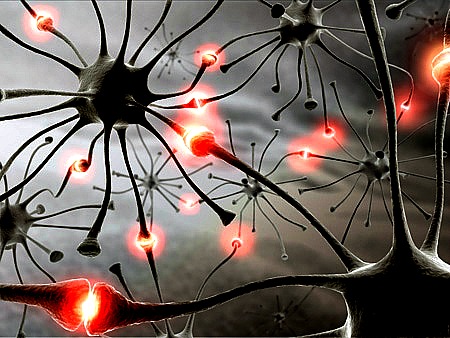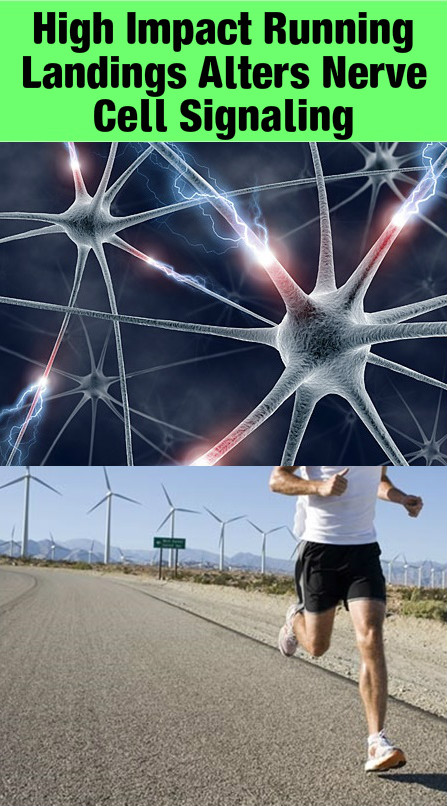Running at faster speeds, while running with a forefoot strike, believe it or not, creates low impact conditions that positively effects nervous cell function in a way that allows nerve cells to communicate better with each other.
How Running Fast, on the Forefoot, Improve Nervous Cell Function
It can be difficult for nerve cellular signalling to adapt to the high repetitive impacts of heel strike running at slower running speeds. However, Faster running speeds promote more efficient motor nerves, allowing greater movement efficiency. For example, sprinters have more efficient motor nerves compared to middle-distance runners [1].
In one study, researchers measured and compared motor nerve conduction velocities of the median nerve and the common fibular nerve in sprinters and middle-distance runners and found that sprinters had faster conduction velocities in both nerves [1], suggesting that sprinters have faster travelling motor information to and from the central nervous system than distance runners.
Physiologically, motor nerves that fire faster are better insulated and are thicker in diameter, which optimizes signal conduction velocity [2], suggesting that through some mechanism, speed-work may improve motor nerve function.
Factors that slow motor nerve conduction velocity includes soft tissue swelling which compresses adjacent nerve fibers, causing a delay in impulse [3, 4], suggesting that a running style with high impact landings (i.e. heel striking) might hinder motor signaling, resulting in less coordinated movements.

- During heel strike running, high impact peaks and transients convert into a shock-wave that travel through the musculoskeletal system causing soft tissue compartments to vibrate at frequencies that cause swelling.
Why Forefoot Running Allows Low Impact Running
- A forefoot strike landing is commonly used by sprinters to eliminate these forces to reduce the risk of injury.
- Forefoot running is also associated with greater stride smoothness –less braking, less impact, better forward momentum– compared to heel strike running.
Heel Strike Causes More than Just Pain
There’s a good chance that a link between high impact landings in heel strike running and alterations in motor nerve function exists.
- Because heel striking produces impact peaks and transients, recurring injury rates tend to be higher in heel strike runners, suggesting that bones, muscles, tendons, and nerves fail to fully adapt to these high loads.
Because delayed motor nerve conduction velocity may precede impact peaks, running faster on the forefoot promotes better integration function of the neuromuscular system, facilitating faster neural transmission and movement efficiency.
More From Run Forefoot:
Patellofemoral Pain Syndrome – Many runners suffer this dreaded injury, but many runners don’t know why. This article covers the main cause of knee injury in runners.
Achilles Heel – Found out why heel strike running is such a daunting task for the Achilles tendon, resulting in injury to the tendon.
Eccentric Exercises – We often hear about eccentric exercises, but you can achieve them just by running barefoot; find out how.
Forefoot Shoe Review – Read my review on the FeelMax Osma 2, an under-appreciated forefoot running shoes that is a great tool to help you mechanically run your best.
References:
[1]. Borges et al. Measurement of motor nerve conduction velocity in three different sports. Rev Bras Med Esporte, 2013; 19(5):328-331.
[2]. am rP. Body fat and its relationship to tibial nerve conduction velocity in a specific population. JOSPT 1987;8:495-7.
[3]. Wei SH, Jong YJ, Chang YJ. Ulnar nerve conduction velocity in injured baseball pitchers. Arch Phys Med Rehabil 2005;86:21-5.
[4]. Çolak T, Bamaç B, Özbek A, Budak F, Bamaç YS. Nerve conduction studies of upper extremities in tennis players. Br J Sports Med 2004;38:632-5.
Bretta Riches
BSc Neurobiology; MSc Biomechanics candidate, ultra minimalist runner & founder of RunForefoot. I was a heel striker, always injured. I was inspired by the great Tirunesh Dibaba to try forefoot running. Now, I'm injury free. This is why I launched Run Forefoot, to advocate the health & performance benefits of forefoot running and to raise awareness on the dangers of heel striking, because the world needs to know.
Latest posts by Bretta Riches (see all)
- Can You Run In Barefoot Shoes? Yes, But DON’T Heel Strike! - 21/07/2024
- Why Cushioned Running Shoes Are Really Bad for Your Feet - 19/07/2024
- Do Cushioned Running Shoes Cause Injuries? - 17/07/2024


49lkft
s43866
32q8w1